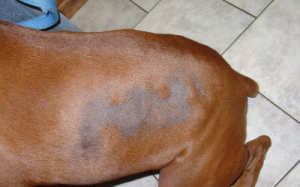News
Canine Flank Alopecia
by admin on October 1st, 2019
Category: News, Tags:
What is canine flank alopecia?
Canine flank alopecia is a localised, often cyclic, disease of the hair follicles resulting in hair loss over the flanks of affected dogs. It is also known by the names cyclic flank alopecia, recurrent flank alopecia and seasonal flank alopecia, but these terms are not always accurate as the condition can appear at various times of the year, vary in duration, be continuous or be sporadic in nature.
What causes flank alopecia?
The cause of this condition is not known. However, as hair loss often occurs at times of the year when day length is at its shortest, light exposure may be involved. The mechanisms by which this might occur are not understood at present.
What are the clinical signs?
Canine flank alopecia occurs in dogs with ages ranging from 1 year to 11 years, although most cases develop between 3 and 6 years. This condition is seen more commonly in breeds such as Boxers, Airedale terriers, English Bulldogs and Schnauzers.
The condition causes areas of non-itchy hair loss over the flanks of affected dogs (Figure 1). The skin at the affected sites usually appears normal, although it often becomes very dark with pigmentation, and hair re-growth of a different colour sometimes occurs. Surrounding hair and skin is usually normal. Canine flank alopecia can occur on both sides of the dog or be limited to one side, and hair loss can also occur over the base of the back (Figure 2). The disease in some dogs is cyclic, with hair loss occurring at the same time each year and hair re-growth occurring in the times between. In other dogs, hair loss is more permanent, and no re-growth is seen following the initial loss. Some dogs are reported as only having one cycle of hair loss and re-growth in their lives.
How is it diagnosed?
The diagnosis of canine flank alopecia can often be made based on the clinical findings, since the lesions are so striking. Some hormonal diseases of dogs can present with non-itchy hair loss, so blood and urine tests may be warranted if there is a concern about these diseases.
Additionally, biopsies of affected skin can be taken which are then sent off for analysis at a laboratory. Biopsies can be supportive of a diagnosis of canine flank alopecia.
What are the treatments available?
Canine flank alopecia is a cosmetic disease. As dogs remain healthy, with many re-growing their hair eventually, a decision not to treat the affected dog is often taken.
If treatment is requested, melatonin is generally considered the treatment of choice as it is relatively safe and inexpensive. It is difficult to judge the response to medication though due to the high rate of spontaneous hair re-growth.
What is the outlook/prognosis?
The prognosis for this cosmetic disease is good, with dogs remaining systemically healthy despite unpredictable hair growth. The prognosis for full and normal hair re-growth at affected sites is also often good, but the disease is highly variable.


